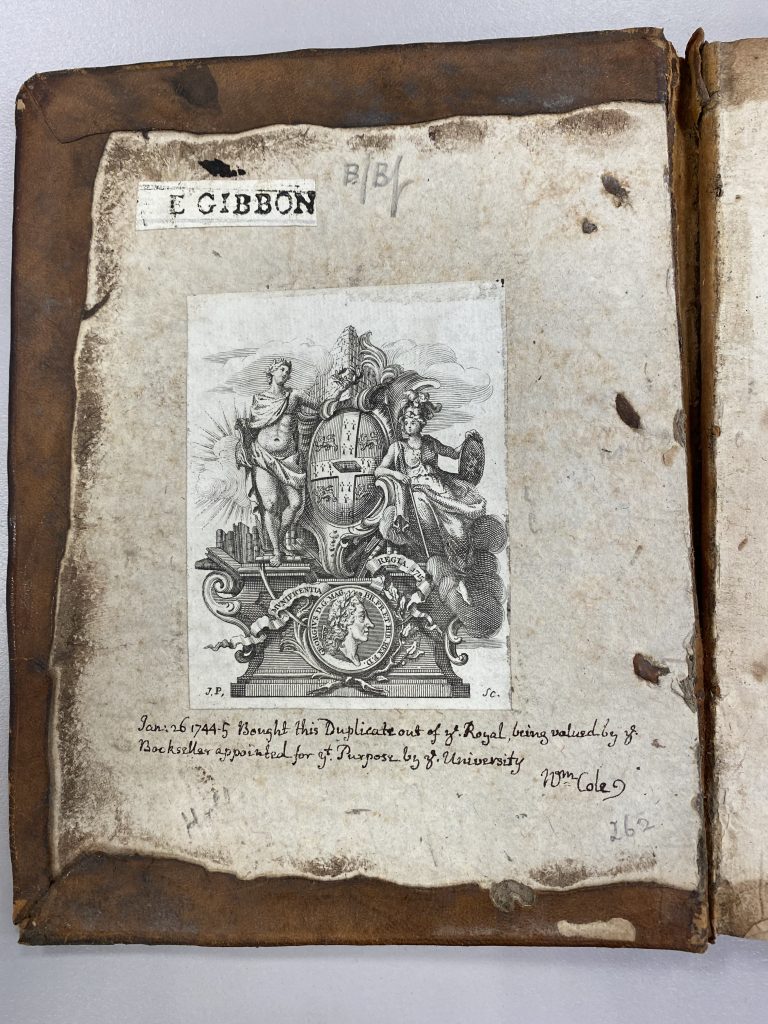Provenance research in rare book cataloguing by Derrick Moors
Dr John Moore (1646-1714) Bishop of Ely held the largest British private library of his day, consisting of approximately 30,000 volumes. He actively collected early printing works including over 40 Caxtons. There was much interest after Moore’s death as to the fate of his collection. It was first offered to the Earl of Oxford for £6000 but after his refusal, was purchased by King George I. in its entirety for £6450, for donation to the Cambridge University Library, in recognition for its loyalty to the new Hanoverian king.
As a result of this donation, which trebled the size of the University’s collection, John Moore’s collection became known as the King’s or Royal Library of the University Library. John Moore rarely annotated or marked his books, and his ownership of a work is now generally only identified by the Royal Library bookplate.
This image of the Royal Library bookplate is from the State Library of Victoria’s copy of Thomæ Hobbes Angli Malmesburiensis philosophi vita. Carolopoli [i.e. London] : Apud Eleutherium Anglicum, sub Signo Vertitatis [i.e. William Crooke], 1682.

Interestingly, a subsequent owner has indicated how he acquired the book. ‘Jan: 26 1744-5 Bought this duplicate out of ye Royal, being valued by ye bookseller appointed for ye purpose by ye University. Wm Cole’. The Rev.William Cole (1714-1782), who was a fellow of Cambridge University, also an historian, has pasted his own bookplate on the verso of the titlepage.

So, 30 years after the donation, the Cambridge University Royal Library was selling off its duplicates, that is, the library already held this title and didn’t need two copies, which is traditional library practice.
On the front end paper above the Royal Library bookplate is the diminutive ownership label of ‘E. Gibbon’. This is Edward Gibbon (1737-1794) historian, writer and Member of Parliament, perhaps best known as the author of his most famous work The history of the decline and fall of the Roman Empire. After Gibbon’s death the portion of his library which he had previously taken to Lausanne, Switzerland, after numerous changes in ownership, was sold in 1832. The State Library’s Hobbes also has evidence of this sale, and its purchaser.

It has the inscription ‘This book I bought at the sale of Gibbons library at Lausanne September 20th 1832. Hughes Francis Ingram’ (1796-1883). The entry in the sale catalogue indicated that Ingram had paid 3 francs for this work ‘Hobbes ( Th . ) Angli malmesburiensis philosophi vita ( a se scripta ) , 1 vol in 4. Carolopoli , Londini 1682. 3 ’.
Nothing further is known about the history of ownership of this book until the State library purchased it in 1929 from ‘Mathews’, presumably a book dealer, for ‘W/n/-’ which is the library code for the purchase price.
None of this provenance history was considered important when this work was acquired. There is no mention of the ownership in the library’s card catalogue. This provenance has only come to light as a result of re-cataloguing fragile or vulnerable items requiring protective boxing. Similarly the British Library also didn’t consider these ownership details significant in their early cataloguing. Fortunately this has changed, and the way which books have been owned, read and used is now considered of real significance.
This post was written by Derrick Moors, Senior Librarian from Collections Development & Description

